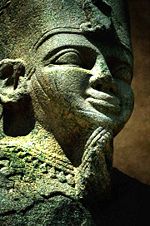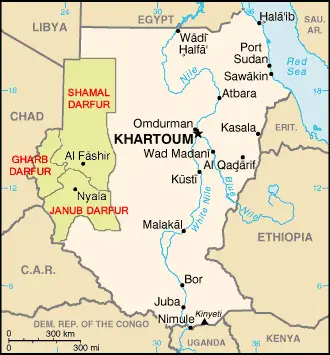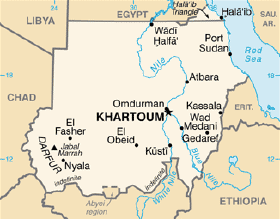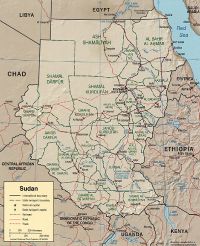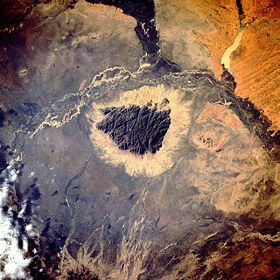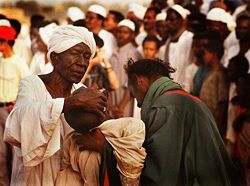Sudan
- For other uses, see Sudan (disambiguation).
| جمهورية السودان Jumhūriyyat as-Sūdān Republic of the Sudan |
||||||
|---|---|---|---|---|---|---|
|
||||||
| Motto: Al-Nasr Lana (Arabic: "Victory is Ours") |
||||||
| Anthem: نحن جند للہ جند الوطن (Arabic: "We Are the Army of God and of Our Land") |
||||||
| Capital | Khartoum | |||||
| Largest city | Omdurman | |||||
| Official languages | Arabic, English | |||||
| Government | Authoritarian Dictatorship | |||||
| - | President | Omar al-Bashir | ||||
| Independence | From Egypt and the UK | |||||
| - | Date | January 1, 1956 | ||||
| Area | ||||||
| - | Total | 2,505,813 km² (10th) 967,495 sq mi |
||||
| - | Water (%) | 6% | ||||
| Population | ||||||
| - | July 2006 estimate | 36,992,490 (33rd) | ||||
| - | 1993 census | 24,940,683 | ||||
| GDP (PPP) | 2005 estimate | |||||
| - | Total | $84.755 billion (62nd) | ||||
| - | Per capita | $2,396 (134th) | ||||
| Currency | Sudanese dinar (SDD) |
|||||
| Time zone | EAT (UTC+3) | |||||
| - | Summer (DST) | not observed (UTC+3) | ||||
| Internet TLD | .sd | |||||
| Calling code | +249 | |||||
The Sudan (officially the Republic of the Sudan or Republic of Sudan) is the largest country by area in Africa, situated in Northern Africa, also the largest Arab country. The capital is Khartoum. It is bordered by Egypt to the north, the Red Sea to the northeast, Eritrea and Ethiopia to the east, Kenya and Uganda to the southeast, Democratic Republic of the Congo and the Central African Republic to the southwest, Chad to the west, and Libya to the northwest. It is the tenth largest country in the world by area.
In recent years, the definite article in the country's name has increasingly been dropped in common usage; i.e., it would be referred to as "Sudan" rather than "the Sudan."
History
Early History of Sudan
Three ancient Kushite kingdoms existed consecutively in northern Sudan. This region was also known as Nubia and Meroë, and these civilizations flourished mainly along the Nile River from the first to the sixth cataracts. The kingdoms were influenced by, and in turn influenced Pharaonic Egypt. In ancient times, Nubia was ruled by Egypt from 1500 B.C.E., to around 1000B.C.E. when the Napatan Dynasty was founded under Alara and regained independence for the kingdom of Kush although borders fluctuated greatly.
Christianity was introduced by missionaries in the 3rd or 4th century, and much of the region was converted to Coptic Christianity. Islam was introduced in 640 C.E. with an influx of Muslim Arabs who had conquered Egypt, although the Christian Kingdoms of Nubia managed to persist until the 15th Century.
A merchant class of Arabs became economically dominant in feudal Sudan. An important kingdom in Nubia was the Makuria, which reached its height in the 8th-9th centuries, and was of the Melkite Christian faith, unlike its Coptic neighbours, Nobatia and Alodia.
Kingdom of Sennar
During the 1500s peoples called the Funj conquered much of Sudan, establishing the Kingdom of Sennar. By the time the kingdom was conquered by Egypt in 1820, the government was substantially weakened by a series of succession arguments and coups within the royal family.
Foreign Control: Egyptian and British
In 1820, Northern Sudan came under Egyptian rule when Mehemet Ali, the Ottoman viceroy of Egypt, sent armies led by his son Ismail Pasha and Mahommed Bey to conquer eastern Sudan. The Egyptians developed Sudan’s trade in ivory and slaves.
Ismail Pasha, khedive of Egypt from 1863-1879, tried to extend Egyptian, and therefore British, influence south. This led to a revolt led by religious leader Muhammad ibn Abdalla, the self-proclaimed Mahdi (Messiah), who sought to purify Islam in Sudan. He led a nationalist revolt against Egyptian/British rule culminating in the fall of Khartoum and the death of the British General Charles George Gordon in 1885. The revolt was successful and Egypt and the British abandoned Sudan, and the resulting state was a theocratic Mahdist state.
In the 1890s the British sought to regain control of Sudan. Lord Kitchener led military campaigns from 1896-98. An agreement was reached in 1899 establishing Anglo-Egyptian Sudan, under which Sudan was run by a governor-general appointed by Egypt with British consent. In reality, Sudan was a colony of Great Britain.
From 1924, until independence in 1956, the British had a policy of running Sudan as two essentially separate colonies, the south and the north.
Independence
The newly elected government went ahead with the process of Sudanization of the state's organs and bodies, with the help and supervision of an international committee. In November 1955, it declared the intentions of the Sudanese people to exercise their right to independence. This was duly granted and on the 1st of January 1956, Sudan was formally declared independent. In a special ceremony held at the People's Palace, the British and Egyptian flags were brought down and the new Sudanese flag, composed of green, blue and yellow stripes, was raised in their place.
First Sudanese Civil War
The year before independence, a civil war began between Northern and Southern Sudan. Southerners, who knew independence was coming, were afraid the new nation would be dominated by the North.
The North of Sudan had historically closer ties with Egypt and was predominately Arab and Muslim. The South of Sudan was predominately black, with a mixture of Christianity and Animism. These divisions had been further emphasized by the British policy of ruling Sudan’s North and South administratively separately. From 1924 it was illegal for people living above the 10th parallel to go further south, and people below the 8th parallel to go further north. The law was ostensibly enacted to prevent the spread of malaria and other tropical diseases that had ravaged British troops, as well as to prevent Northern Sudanese from raiding Southern tribes for slaves. The result was increased isolation between the already distinct north and south and arguably laid the seeds of conflict in the years to come.
The resulting conflict was known as the civil war and lasted from 1955 to 1972. In 1972, the Addis Ababa Agreement led to a cessation of the north-south civil war and a degree of self-rule. This led to a ten-year hiatus in the civil war. Under the Addis Ababa Agreement Southern Sudan was given considerable autonomy.
Second Sudanese Civil War
In 1983 the civil war was reignited following President Gaafar Nimeiry’s decision to circumvent the Addis Ababa Agreement. President Gaafar Nimeiry attempted to create a Federated Sudan including states in Southern Sudan, which violated the Addis Ababa Agreement which had granted the South considerable autonomy. The Sudan People's Liberation Army formed in May 1983 as a result. Finally, in June 1983, the Sudanese Government under President Gaafar Nimeiry abrogated the Addis Ababa Peace Agreement (A.A.A.)[1]. The situation was exacerbated after President Gaafar Nimeiry went on to implement Sharia Law in September of the same year [2].
The civil war went for more than 20 years, resulting in the deaths of 2.2 million Christians and Animists, and displacing roughly 4.5 million people within Sudan and into neighbouring countries. It damaged Sudan’s economy and led to food shortages, resulting in starvation and malnutrition. The lack of investment during this time, particularly in the south, meant a generation lost access to basic health services, education, and jobs.
Peace talks between the southern rebels and the government made substantial progress in 2003 and early 2004. The peace was consolidated with the official signing by both sides of the Naivasha treaty on 9 January 2005, granting Southern Sudan autonomy for six years, to be followed by a referendum about independence. It created a co-vice president position and allowed the north and south to split oil equally, but also left both the North's and South's armies in place. John Garang, the south's elected co-vice president died in a helicopter crash on August 1, 2005, three weeks after being sworn in. This resulted in riots, but the peace was eventually able to continue.
The United Nations Mission in Sudan (UNMIS) was established under UN Security Council Resolution 1590 of March 24, 2005. Its mandate is to support implementation of the Comprehensive Peace Agreement, and to perform functions relating to humanitarian assistance, and protection and promotion of human rights.
Darfur Conflict
Just as the long North-South civil war was reaching a resolution, a new rebellion in the western region of Darfur began in early 1970's, right after Africa's greatest famine. The rebels accused the central government of neglecting the Darfur region economically, although there is uncertainty regarding the objectives of the rebels and whether they merely seek an improved position for Darfur within Sudan or outright "secession." Both the government and the rebels have been accused of atrocities in this war, although most of the blame has fallen on Arab militias Janjaweed armed men appointed by Al Saddiq Al Mahdi administration to stop the long went chaotic disputes between Darfur tribes. The rebels have alleged that these militias have been engaging in the genocide, and the fighting has displaced hundreds of thousands of people, many of them seeking refuge in neighboring Chad. The government claimed victory over the rebels after capturing, a town on the border with Chad, in early 1994, despite the continuing violence. But as of 2006, the War in Darfur continues with the humanitarian situation getting worse.
On September 9, 2004 the United States Secretary of State Colin Powell termed the Darfur conflict as a "genocide," making it one of the worst humanitarian crisis of the 21st century[1]. There have been reports that the Janjaweed have been launching raids, bombings, and attacks on villages, killing civilians based on ethnicity, raping women, stealing land, goods, and herds[2]. So far, an estimated 400,000 civilians have been killed with over 2.5 million displaced[3].
On May 5, 2006, the Sudanese government and Darfur's largest rebel group the SLM (Sudan Liberation Movement) signed the "Darfur Peace Agreement," which aimed at ending the three-year long conflict[4]. The agreement specified the disarmament of the janjaweed and the disbandment of the the rebel forces and aimed at establishing a temporal government which the rebels could take part[5]. The agreement, which was brokered by the African Union, however, was not signed by all of the rebel groups[6].
Since the agreement was signed, however, there still have been reports of wide-spread violence throughout the region. A new rebel group has emerged called the "National Redemption Front" (which is made up of the 4 main rebel groups who refused to sign the May peace agreement)[7]. Recently, both the Sudanese government and government-sponsored militas have launched large offensives against the rebel groups, resulting in the more deaths and more displacements. Clashes among the rebel groups have also contributed to the violence[8]. Recent fighting along the Chad border has left hundreds of soldiers and rebel forces dead and nearly a quarter of a million refugees cut from aid[9]. In addition, villages have been continuously bombed and more innocent civilians have been killed. UNICEF recently reported that around 80 infants die each day in Darfur as a result of malnutrition[10].
The people in Darfur are predominately black and Muslim, whereas Janjaweed militias are black and Muslim as well. Janjaweed are labelled "Arabs" for their nomadic lifestyle.
Chad-Sudan conflict
The Chad-Sudan conflict officially started on December 23, 2005, when the government of Chad declared a state of war with Sudan and called for the citizens of Chad to mobilize themselves against the "common enemy," which the Chadian government sees as the Rally for Democracy and Liberty (RDL) militants, Chadian rebels backed by the Sudanese government, and Sudanese militiamen. Militants have attacked villages and towns in eastern Chad, stealing cattle, murdering citizens, and burning houses. Over 200,000 refugees from the Darfur region of northwestern Sudan currently claim asylum in eastern Chad. Chadian president Idriss Déby accuses Sudanese President Omar Hasan Ahmad al-Bashir of trying to "destabilize our country, to drive our people into misery, to create disorder and export the war from Darfur to Chad."
The incident prompting the declaration of war was an attack on the Chadian town of Adré near the Sudanese border that led to the deaths of either one hundred rebels (as most news sources reported) or three hundred rebels. The Sudanese government was blamed for the attack, which was the second in the region in three days, but Sudanese foreign ministry spokesman Jamal Mohammed Ibrahim denied any Sudanese involvement, "We are not for any escalation with Chad. We technically deny involvement in Chadian internal affairs." The Adre attack led to the declaration of war by Chad and the alleged deployment of the Chadian airforce into Sudanese airspace, which the Chadian government denies.
Politics
Sudan has an authoritarian government in which all effective political power is in the hands of President Umar Hassan al-Bashir. Bashir and his party have controlled the government since he led the military coup on 30 June 1989.
From 1983 to 1997, the country was divided into five regions in the north and three in the south, each headed by a military governor. After the April 6, 1985 military coup, regional assemblies were suspended. The RCC was abolished in 1996, and the ruling National Islamic Front changed its name to the National Congress Party. After 1997, the structure of regional administration was replaced by the creation of 26 states. The executives, cabinets, and senior-level state officials are appointed by the president, and their limited budgets are determined by and dispensed from Khartoum. The states, as a result, remain economically dependent upon the central government. Khartoum state, comprising the capital and outlying districts, is administered by a governor.
In December 1999, a power struggle climaxed between President al-Bashir and then-speaker of parliament Hassan al-Turabi, who was the NIF founder and an Islamist ideologue. Al-Turabi was stripped of his posts in the ruling party and the government, parliament was disbanded, the constitution was suspended, and a state of national emergency was declared by presidential decree. Parliament resumed in February 2001 after the December 2000 presidential and parliamentary elections, but the national emergency laws remain in effect. Al-Turabi was arrested in February 2001, and charged with being a threat to national security and the constitutional order for signing a memorandum of understanding with the SPLA. Since then his outspoken style has had him in prison or under house-arrest, his most recent stint beginning in March of 2004 and ending in June of 2005. During that time he was under house-arrest for his role in a failed coup attempt in September of 2003, an allegation he has denied. According to some reports, the president had no choice but to release him, given that a coalition of National Democratic Union (NDA) members headquartered in both Cairo and Eritrea, composed of the political parties known as the SPLM/A, Umma Party, Mirghani Party, and Turabi's own National People's Congress, were calling for his release at a time when an interim government was preparing to take over in accordance with the Naivasha agreement and the Machokos Accord.
See also: Presidents of Sudan
Foreign relations
Sudan has had a troubled relationship with many of its neighbors and much of the international community due to what is viewed as its aggressively Islamic stance. For much of the 1990s, Uganda, Kenya and Ethiopia formed an ad-hoc alliance called the "Front Line States" with support from the United States to check the influence of the National Islamic Front government. During this period, Sudan supported anti-Uganda rebel groups such as the Lord's Resistance Army in retaliation for Ugandan support of the Sudan People's Liberation Army. Beginning from the mid-1990s Sudan gradually began to moderate its positions as a result of increased US pressure following the 1998 U.S. embassy bombings and the new development of oil fields previously in rebel hands. Sudan also has a territorial dispute with Egypt over the Hala'ib Triangle. Since 2003, the foreign relations of Sudan have centered on the support for ending the Second Sudanese Civil War and condemnation of government support for militias in the Darfur conflict.
U.S. firms have been barred from doing business in Sudan since 1997.[3]
On December 23, 2005 Chad, Sudan's neighbor to the west, declared war on Sudan and accused the country of being the "common enemy of the nation (Chad)." This happened after the December 18 attack on Adre, which left about 100 people dead. A statement issued by Chadian government on December 23, accused Sudanese militias of making daily incursions into Chad, stealing cattle, killing innocent people and burning villages on the Chadian border. The statement went on to call for Chadians to form a patriotic front against Sudan.[4] The Organization of the Islamic Conference(OIC) have called on Sudan and Chad to exercise self-restraint to defuse growing tensions between the two countries.[5]
On December 27, 2005, Sudan became one of the few states to recognize Moroccan sovereignty over Western Sahara. [6]
On June 20, 2006 President Omar al-Bashir told reporters that he would not allow any UN peacekeeping force into Sudan. President al-Bashir denounced any such mission as "colonial forces." [7]
Human Rights
An August 14th letter from the Executive Director of the Human Rights Watch found that the Sudanese government is both incapable and unwilling to protect its own citizens in Darfur and that its militias are guilty of crimes against humanity. The letter added that these human rights abuses have existed since 2004.[8]
Both government forces and militias allied with the government are known not only to attack civilians in Darfur, but also humanitarian workers. Sympathizers of rebel groups are arbitrarily detained, as are foreign journalists, human rights defenders, student activists, and displaced people in and around Khartoum, some of whom face torture. [9]
The Sudan practices capital punishment and it can be applied to minors. [10]
Slavery has been carried out by the Dinka tribe in the south. Former vise president and rebel leader, John Garang, enforced child military conscription in the South in order to strengthen his movement.
Administrative divisions
Main articles: States of Sudan, Districts of Sudan
Sudan is divided into 26 states or wilayat, and subdivided into 133 districts.
The states include: Al Jazirah, Al Qadarif, Bahr al Jabal, Blue Nile, East Equatoria, Junqali, Kassala, Khartoum, Lakes, North Bahr al Ghazal, North Darfur, North Kurdufan, Northern, Red Sea, River Nile, Sennar, South Darfur, South Kurdufan, Unity, Upper Nile, Warab, West Bahr al Ghazal, West Darfur, West Equatoria, West Kurdufan, and White Nile.
Districts: see Districts of Sudan
Autonomy, separation, and conflicts
Southern Sudan is an autonomous region intermediate between the states and the national government. Southern Sudan is scheduled to have a referendum on independence in six years as of 2006.
Darfur is a region of three western states affected by the current Darfur conflict. There is also an insurgency in the east led by the Eastern Front.
Geography
Sudan is situated in Northern Africa, bordering the Red Sea, between Egypt and Eritrea. It is dominated by the River Nile and its tributaries. With an area of 2,505,810 square kilometres (967,499 sq mi), it is the largest country in the continent and tenth largest in the world. The terrain is generally flat plains, though there are mountains in the east and west. The climate is tropical in the south; arid desert conditions in the north, with a rainy season from April to October. Soil erosion and desertification are environmental hazards.
See also: List of cities in Sudan
Economy
Sudan has turned around a struggling economy with sound economic policies and infrastructure investments, but it still faces formidable economic problems as it must rise from a very low level of per capita output. Since 1997 Sudan has been implementing the macroeconomic reforms recommended by the IMF. In 1999. Sudan began exporting crude oil and in the last quarter of 1999 recorded its first trade surplus. Increased oil production,,(the current production is half a million barrels a day) revived light industry, and expanded export processing zones helped sustain GDP growth at 6.1% in 2003. These gains, along with improvements to monetary policy, have stabilized the exchange rate. Currently oil is Sudan's main export, and the production is increasing dramatically. With rising oil revenues the Sudanese economy is booming at a growth rate of nearly 7% in 2005.
Agriculture production remains Sudan's most important sector, employing 80% of the work force and contributing 39% of GDP, but most farms remain rain-fed and susceptible to drought. Chronic instability — including the long-standing civil war between the Muslim north and the Christian/animist south, adverse weather, and weak world agricultural prices — ensure that much of the population will remain at or below the poverty line for years.
See also: Communications in Sudan, Transportation in Sudan
Demographics
In Sudan’s 1993 census, the population was calculated at 25 million. No comprehensive census has been carried out since that time due to the continuation of the civil war. Current estimates from the United Nations as of 2006 estimate the population to be about 37 million. The population of metropolitan Khartoum (including Khartoum, Omdurman, and Khartoum North) is growing rapidly and is estimated at about 5-6 million, including around 2 million displaced persons from the southern war zone as well as western and eastern drought-affected areas.
Sudan has two distinct major cultures—Arabs with Nubian (Kushite) roots and non-Arab Black Africans—with hundreds of ethnic and tribal divisions and language groups, which makes effective collaboration among them a major problem.
The northern states cover most of the Sudan and include most of the urban centers. Most of the 22 million Sudanese who live in this region are Arabic-speaking Muslims, though the majority also use a traditional non-Arabic mother tongue — e.g., Nubian, Beja, Fur, Nuban, Ingessana, etc. Among these are several distinct tribal groups: the Kababish of northern Kordofan, a camel-raising people; the dongolese (الدنقلاويين),the Ga’alin (الجعلين), Rubatab (الرباطاب), Manasir (المناصير) and Shaiqiyah (الشايقيّة) of the tribes settling along the rivers; the seminomadic Baggara of Kurdufan and Darfur; the Beja in the Red Sea area and Nubians of the northern Nile areas, some of whom have been resettled on the Atbara River. Shokrya in the Butana land, Bataheen bordering the Ga’alin and Shorya in the south west of Butana. Rufaa, Halaween and many other tribes in the Gazeera region and on the banks of the Blue Nile and the Dindir region. The Nuba of southern Kurdufan and Fur in the western reaches of the country.
The southern region has a population of around 6 million and a predominantly rural, subsistence economy. This region has been affected by war for all but 10 years since independence in 1956, resulting in serious neglect, lack of infrastructure development, and major destruction and displacement. More than 2 million people have died, and more than 4 million are internally displaced or have become refugees as a result of the civil war and war-related impacts. Here a majority of the population practices traditional indigenous beliefs, although some practice Christianity, partly a result of Christian missionary efforts and partly a holdover from earlier Christian Nubian civilizations. The south also contains many tribal groups and many more languages are used than in the north. The Dinka, whose population is estimated at more than 1 million, are the largest of the many black African tribes of the Sudan. Along with the Shilluk and the Nuer they are Nilotic tribes. The Azande, Bor, and Jo Luo are “Sudanic” tribes in the west, and the Acholi and Lotuhu live in the extreme south, extending into Uganda.
People of Sudan
- Ja'alein
- Arakeien
- Shigia
- Rubatab
- Shokrya
- Ababda
- Azande
- Baggara peoples
- Beja tribe
- Dinka tribe
- Luo tribe
- Fulbe (Fulani) people
- Fur people
- Hawsa
- Horefaen
- Mahas
- Manasir tribe
- Masalit
- Nuba peoples
- Nuer tribe
- Rashaida people
- Zaghawa
(more, with rough locations)
- Acholi east
- Ayuak south central
- Barit Juba
- Didiga east
- Fulbe (Fulani) people Blue Nile, East and Tulus
- Kakua southwest
- Latuga east
- Madi east
- Shililuk east
- Toposa east
- many more
Official languages
According to the Constitution 2005, Official languages are the Arabic and English languages.
article 8:
1) All indigenous languages of the Sudan are national languages and shall be respected, developed and promoted.
2) Arabic is a widely spoken national language in the Sudan.
3) Arabic, as a major language at the national level and English shall be the official working languages of the national government and the languages of instruction for higher education.
4) In addition to Arabic and English, the legislature of any sub-national level of government may adopt any other national language as an additional official working language at its level.
5) There shall be no discrimination against the use of either Arabic or English at any level of government or stage of education.
Culture
- Culture of Sudan
- Music of Sudan
- List of writers from Sudan
- Islam in Sudan
Sudan's largest Christian denominations are the Roman Catholic Church, the Episcopal Church of the Sudan, the Presbyterian Church in the Sudan and the Coptic Orthodox Church.
Education
Institutions of higher education in the Sudan include:
- Academy of Medical Sciences
- Ahfad University for Women
- Bayan Science and Technology College
- Computerman College
- Omdurman Ahlia University
- Omdurman Islamic University
- University of Gezira
- University of Juba
- University of Khartoum
- Mycetoma Research Centre
- Sudan University of Science and Technology
Credits
New World Encyclopedia writers and editors rewrote and completed the Wikipedia article in accordance with New World Encyclopedia standards. This article abides by terms of the Creative Commons CC-by-sa 3.0 License (CC-by-sa), which may be used and disseminated with proper attribution. Credit is due under the terms of this license that can reference both the New World Encyclopedia contributors and the selfless volunteer contributors of the Wikimedia Foundation. To cite this article click here for a list of acceptable citing formats.The history of earlier contributions by wikipedians is accessible to researchers here:
The history of this article since it was imported to New World Encyclopedia:
Note: Some restrictions may apply to use of individual images which are separately licensed.
- ↑ http://www.usatoday.com/news/washington/2004-09-09-sudan-powell_x.htm
- ↑ http://www.truthout.org/cgi-bin/artman/exec/view.cgi/38/9182
- ↑ http://www.genocideintervention.net/educate/darfurinfo/
- ↑ http://www.state.gov/r/pa/prs/ps/2006/65972.htm
- ↑ http://news.bbc.co.uk/2/hi/africa/4978668.stm
- ↑ http://news.bbc.co.uk/2/hi/africa/4978668.stm
- ↑ http://www.guardian.co.uk/sudan/story/0,,1893427,00.html
- ↑ http://www.guardian.co.uk/sudan/story/0,,1893427,00.html
- ↑ http://www.strategypage.com/qnd/sudan/articles/20061011.aspx
- ↑ http://www.napavalleyregister.com/articles/2006/10/08/news/world/iq_3633567.txt


